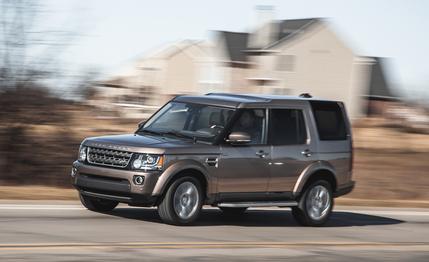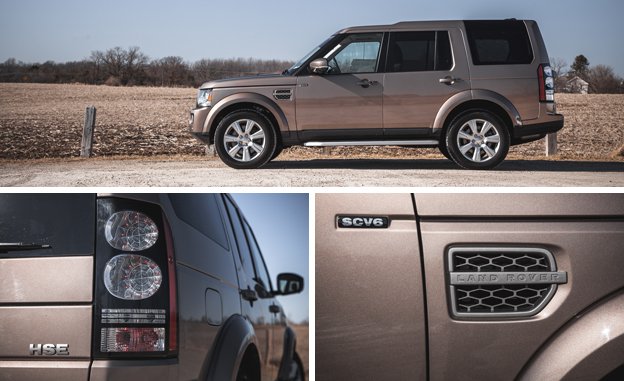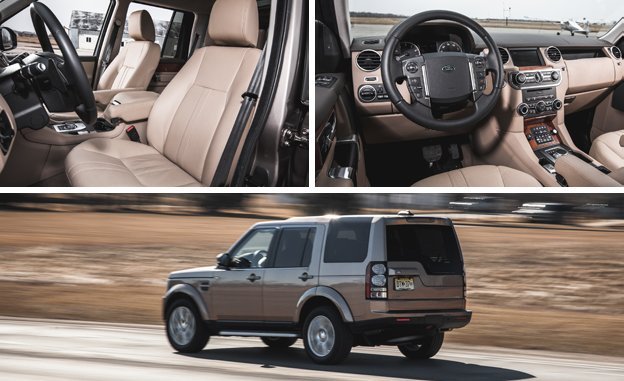
 Instrumented Test
Instrumented Test
In an industry rapidly pivoting toward downsized engines in both cylinder count and displacement—but not power—the Land Rover LR4 stands out as one of the less successful experiments. Last year, the LR4 was stripped of its 375-hp 5.0-liter V-8 and six-speed automatic transmission; fitted in their stead was a 340-hp supercharged 3.0-liter V-6 and an eight-speed automatic. You’ll note that 340 horsepower is significantly less than 375, and the V-6’s 332 lb-ft of torque is down from the old V-8’s 375 lb-ft. Moving from the spec page into the real world, our test of a 2015 Land Rover LR4 with the new V-6 confirms that in this case, the downsizing effort fails to deliver the equal-power-with-better-fuel-economy downsizing magic.
Starting with the topic of acceleration, our numbers say that the 2015 LR4 is 0.2-second slower to 60 mph than the quickest V-8–powered LR4 we’ve tested. Out in the real world, the LR4 feels even more lethargic, especially at higher speeds where the V-6’s 340 horsepower struggles to overcome the SUV’s blunt aerodynamics. The new eight-speed automatic certainly shifts better than the old six-speed unit, but it’s hesitant to downshift, and to avoid slowing your progress upon hitting a hill at highway speeds, you’ll find yourself dipping deeper into the gas pedal until the gearbox downshifts.


The impetus behind downsizing engines, of course, is to improve fuel economy. Here, too, the LR4 stumbles. The new drivetrain is now EPA rated at 15/19 mpg city/highway versus the previous 12/17 mpg, but our 2015 test car managed only 15 mpg—precisely the same fuel efficiency we saw in a 2011 LR4 with the V-8. Part of this we’re attributing to weight, as the 2015 LR4 inexplicably weighs nearly 200 pounds more than the last LR4 we tested, despite being almost identically equipped. (The LR4 has yet to inherit an aluminum structure that has worked weight-loss wonders for the Land Rover Range Rover, Range Rover Sport, and Discovery Sport. It will do so when a new generation launches soon as the Discovery.) The mass, combined with an intrusive stability-control system, limited the LR4 to a frankly pathetic 0.65 g on the skidpad. (We even managed to set off the electronic stability-control system on a few highway on-ramps in the dry.) That level of competency nearly dips down to Mercedes-Benz G550 territory, a solid-axle relic designed in the 1970s. The Land Rover’s braking, by contrast, is actually acceptable at 174 feet from 70 mph, but it’s accompanied by old-timey body dive.
We understand that not every LR4 owner expects BMW-fighting driving dynamics, and reassuringly, in every other metric the Land Rover passes with flying colors. The boxy styling looks good and has held up over time, and the interior is awash in fine materials and plenty of light from the massive amount of glass. The LR4 is one of the few modern vehicles with a genuinely low cowl, and combined with the tall roof it returns the sensation of extreme roominess and excellent forward and side vision. The same floaty suspension that so hinders the LR4 on the skidpad returns a cosseting ride, which is nice, and we never thought twice when the relatively tall-sidewall 19-inch tires dove into Detroit’s most brutal potholes.


Our midlevel LR4 HSE test model came standard with the third-row chairs of the Seven Seat Comfort package (it’s optional on the base LR4). The HSE also brings navigation, xenon headlights, 19-inch wheels, front parking sensors, passive entry, and power-folding door mirrors. Room in the third row is acceptable (and headroom is killer), but like most way-back seating setups, it’s best left for children. The $1500 Climate Comfort package added heating elements to the first- and second-row (outboard) seats as well as the steering wheel and windshield, while the $1600 Vision Assist package brought adaptive headlights, automatic high beams, blind-spot monitoring, and parking cameras. The $1350 Heavy Duty package (two-speed transfer case, rock-crawl mode, full-size spare, and locking rear differential), $750 Sirius satellite radio, $541 Protection package, and $138 wheel locks rounded out our test car’s equipment list for a grand total of $62,104.
For the amount of luxury and off-road capability you get, the LR4 isn’t a bad deal—especially when you compare its price to that of three-row luxury SUV competitors such as BMW’s X5, Audi’s Q7, and the Mercedes-Benz GL-class—and non-enthusiasts won’t be put off by the dynamic shortcomings. We only wish the new engine delivered more of its supposed benefits. Maybe if we ask nicely enough, Land Rover will reintroduce the old V-8.